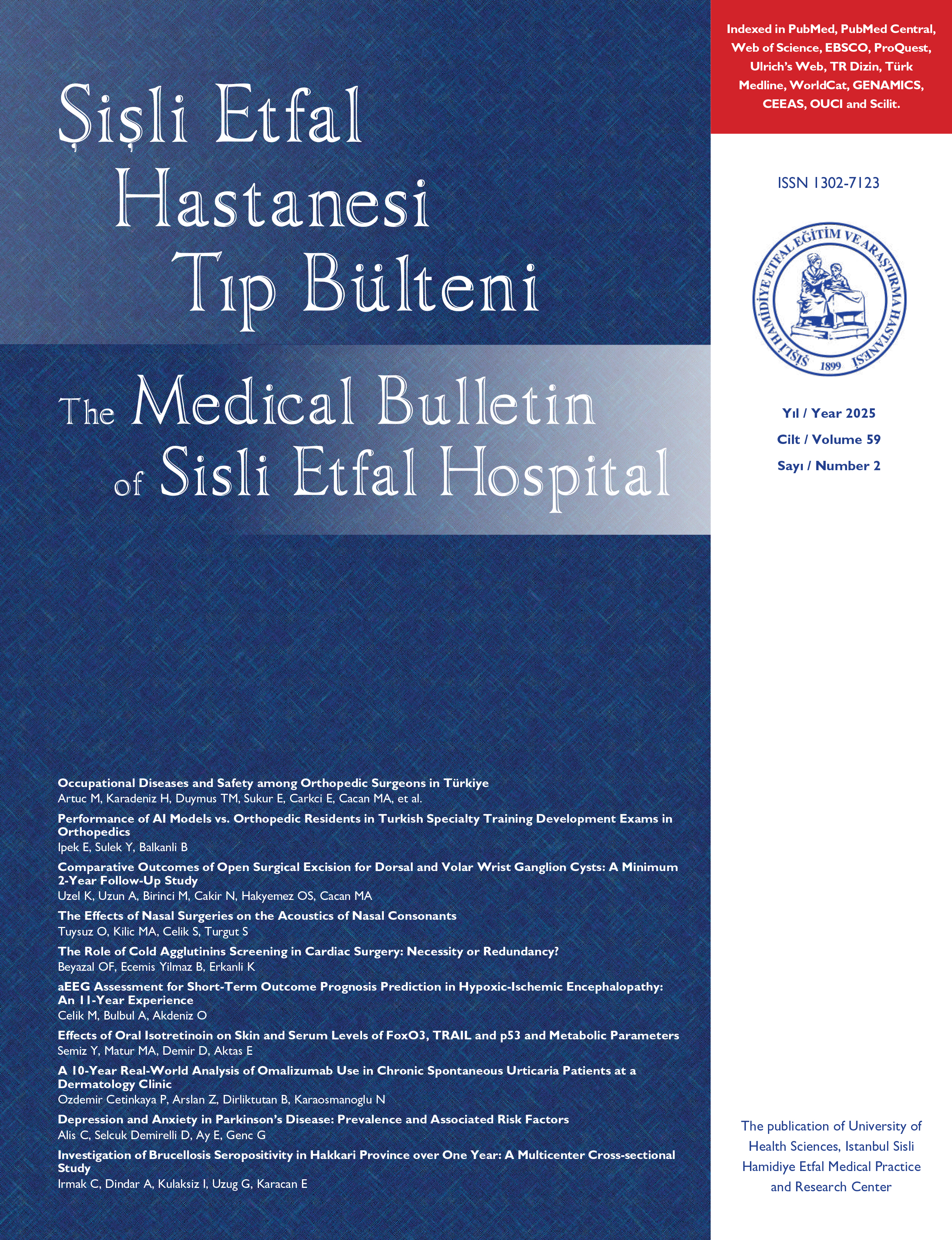
Factors Influencing the Relationship of the External Branch of the Superior Laryngeal Nerve with the Superior Pole Vessels of the Thyroid Gland
Nurcihan Aygun1, Mahmut Kaan Demircioğlu1, Zeynep Gül Demircioğlu1, Adnan Isgor2, Mehmet Uludag11Sağlık Bilimleri Üniversitesi, Şişli Hamidiye Etfal Eğitim ve Araştırma Hastanesi, Genel Cerrahi Kliniği, İstanbul2Bahçeşehir Üniversitesi Tıp Fakültesi, Genel Cerrahi Anabilim Dalı, İstanbul
Objectives: In a thyroidectomy, the external branch of the superior laryngeal nerve (EBSLN) is a potential risk during the superior pole dissection due to its close anatomical relationship with the superior thyroid artery and its highly variable anatomy. In this study, we aimed to evaluate the relationship of EBSLN with the superior pole considering Cernea classification and the factors affecting this relationship.
Methods: The data of thyroidectomized 126 patients (95 female, 31 male) with 200 neck sides (mean age of 45.6±12.1 years) using intraoperative neuromonitoring (IONM) for the EBSLN exploration were evaluated retrospectively. During the superior pole dissection, the EBSLN course was classified according to Cernea classification after being confirmed with IONM. It was defined as a large goiter in the case of the thyroid lobe volume being >50 cc. The factors influencing the presence of type 2b, which has the highest risk of injury, were evaluated using logistic regression analysis.
Results: Of the 200 EBSLNs evaluated, 52 (26%) were type 1, 134 (68%) were type 2a, and 14 (7%) were type 2b. The mean volumes of the resected thyroid lobes were 22±25 cc (min-max: 2-136), 23±20 cc (3-163), and 39±24 cc (3-65) in type 1, 2a and 2b, respectively, which was significantly higher in type 2b (p=0.035). Presence of large goiter rates were 5.8% (n=3), 8.2% (n=11), 64.3% (n=9) in type 1, 2a, and 2b, respectively, and was significantly higher in type 2b (p=0.0001). There was no significant difference between EBSLN Cernea types concerning age, sex, nerve side, presence of cancer and hyperthyroidism. In logistic regression analysis, large goiter was the only independent factor associated with Cernea type 2b. In case of a lobe volume greater than 50 cc, the probability of type 2b presence was approximately 25 times higher (p<0.001, odds ratio: 25.262).
Conclusion: Type 2b course of EBSLN is more common in large goiters, and it is 25 times more likely to be seen in the presence of a lobe volume over 50 cc. Thus, it should be considered that the probability of this high-risk course is significantly higher in large goiters. (SETB-2020-09-184)
Factors Influencing the Relationship of the External Branch of the Superior Laryngeal Nerve with the Superior Pole Vessels of the Thyroid Gland
Nurcihan Aygun1, Mahmut Kaan Demircioğlu1, Zeynep Gül Demircioğlu1, Adnan Isgor2, Mehmet Uludag11Department of General Surgery, University of Health Sciences Turkey, Sisli Hamidiye Etfal Teaching and Research Hospital, Istanbul, Turkey2Department of General Surgery, Bahcesehir University Faculty of Medicine, Istanbul, Turkey
Objectives: In a thyroidectomy, the external branch of the superior laryngeal nerve (EBSLN) is a potential risk during the superior pole dissection due to its close anatomical relationship with the superior thyroid artery and its highly variable anatomy. In this study, we aimed to evaluate the relationship of EBSLN with the superior pole considering Cernea classification and the factors affecting this relationship.
Methods: The data of thyroidectomized 126 patients (95 female, 31 male) with 200 neck sides (mean age of 45.6±12.1 years) using intraoperative neuromonitoring (IONM) for the EBSLN exploration were evaluated retrospectively. During the superior pole dissection, the EBSLN course was classified according to Cernea classification after being confirmed with IONM. It was defined as a large goiter in the case of the thyroid lobe volume being >50 cc. The factors influencing the presence of type 2b, which has the highest risk of injury, were evaluated using logistic regression analysis.
Results: Of the 200 EBSLNs evaluated, 52 (26%) were type 1, 134 (68%) were type 2a, and 14 (7%) were type 2b. The mean volumes of the resected thyroid lobes were 22±25 cc (min-max: 2-136), 23±20 cc (3-163), and 39±24 cc (3-65) in type 1, 2a and 2b, respectively, which was significantly higher in type 2b (p=0.035). Presence of large goiter rates were 5.8% (n=3), 8.2% (n=11), 64.3% (n=9) in type 1, 2a, and 2b, respectively, and was significantly higher in type 2b (p=0.0001). There was no significant difference between EBSLN Cernea types concerning age, sex, nerve side, presence of cancer and hyperthyroidism. In logistic regression analysis, large goiter was the only independent factor associated with Cernea type 2b. In case of a lobe volume greater than 50 cc, the probability of type 2b presence was approximately 25 times higher (p<0.001, odds ratio: 25.262).
Conclusion: Type 2b course of EBSLN is more common in large goiters, and it is 25 times more likely to be seen in the presence of a lobe volume over 50 cc. Thus, it should be considered that the probability of this high-risk course is significantly higher in large goiters.
Makale Dili: İngilizce



















